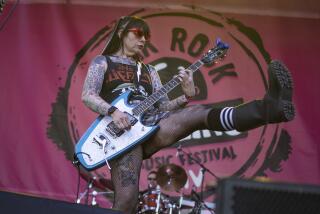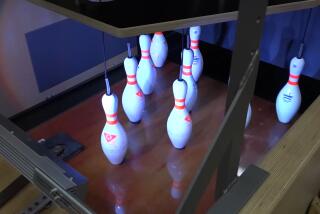Bowling Innovations Return Sport to Fast Lane
- Share via
MUSKEGON, Mich. — Bowling is making a comeback of sorts--with yuppies and an Olympic exhibition--thanks in part to a company that has called this Lake Michigan city home for the past 82 years.
Having helped rejuvenate the sport with remodeled centers, automatic scoring screens and livelier pins, Brunswick Bowling and Billiards is among those basking in the glow of a bowling renaissance.
“Bowling is finally getting the recognition it deserves as a competitive sport--and it’s about time,” said Thomas R. Weigt, president and general manager of the bowling division.
The only thing missing at the Brunswick plant here is the crack of the ball crashing against the pins. And maybe the beer.
Almost everything else one would expect to see at a bowling alley can be found at the 1-million-square-foot plant. Bowling balls, pins, lanes and electronic scorekeepers are manufactured and distributed worldwide from the Muskegon operation, which is a division of the $2-billion Skokie, Ill.,-based Brunswick Corp.
Small Part of the Business
Though Brunswick is practically synonymous with bowling, the bowling division, with 550 employees, represents less than 10% of the parent corporation’s business. The major business over the past several years has come from its pleasure boating operations and marine engine businesses.
Still, the 143-year-old company remains a leader in the bowling equipment industry along with rival AMF Bowling.
As a major promoter of the sport, Brunswick plans to be a principal sponsor this summer when bowling is rolled out as an exhibition sport in the Olympics.
In addition to lobbying for Olympic status, Brunswick has been at the forefront of product development. The company’s urethane ball, the Rhino, was introduced two years ago and has been highly successful. A new line of brightly colored balls for children was introduced in January. Brunswick calls them the Odd Balls.
Altogether, the company makes six series of balls in dozens of weights and colors. They include the traditional rubber ball, which can retail for as little as $25, the middle-of-the-line polyester ball and the top-of-the-line Rhino, which can retail at up to $130.
The company has introduced a more durable, nylon-injected pin, the Brunswick Flyer, which increases pin action and can boost scores. The company is providing pins for the Olympics.
Synthetic Lanes
Brunswick’s bowling lanes are now synthetic, which make them easier to care for than wood lanes and provide a more consistent rolling surface. The approximately 70-foot lanes are shipped in 20-foot segments.
Brunswick Recreation Centers division in Skokie, the biggest operator of bowling centers in the country, has opened 12 flashy new centers in the Sun Belt since 1983. One of them has a state-of-the-art fitness center attached.
“We call them bowling ‘centers’ now,” Weigt said. “We’re trying to change bowling’s image. Bowling’s always been tied to Ralph Kramden and Archie Bunker . . . and we’re trying to show that it’s not at all a low-class kind of sport.”
Part of the modernization effort centers around Brunswick’s AS-80 Colorvision automatic scorer, which is manufactured in Muskegon.
“It’s taken all the work out of bowling,” Weigt said of the product introduced in 1983 and now in nearly 20% of the approximately 8,000 bowling centers in the country.
The automatic scorers can also double as video screens, and proprietors can use them to show videotapes, or even live television. At Garden Bowl in Detroit, the oldest center in Michigan, the screens are used for music videos on certain nights to draw teen-agers for “Rock ‘n’ Bowl.”
Long Overdue Promotions
“We’ve got neon lighting too,” manager David Zainea said.
Such promotions are relatively new for the bowling industry, but they are long overdue, said Bryan Collins, vice president of marketing at Brunswick’s bowling division.
“We’re seeing remodeled centers with such things as no-smoking sections,” Collins said. “These things are finally being addressed. Surveys are finally being done to find out who’s bowling.”
Demographic surveys of the nation’s 22 million casual bowlers and 8 million league bowlers are the job of the National Bowling Council, the industry’s advertising arm.
“Our profiles show that today’s average bowler is younger, more affluent, better educated and more family oriented than the national average,” said Robbie Puno, marketing services manager for the council.
More and more professionals--doctors, lawyers and accountants among them--are joining leagues, said Jerry Rangel, director of marketing services for Bowling Proprietors of America.
“Owners are spending a lot of money on remodeling to attract the so-called yuppie market,” he said. “We’ve gone from hard plastic chairs and Formica to carpeting and earth tones. It’s to make it look more like a country club than a bowling alley.”
One of the reasons professional people are drawn to the game is its ability to relieve stress, Collins said.
“There’s nothing like taking a heavy ball and throwing it at something to get rid of stress,” he said.
More to Read
Go beyond the scoreboard
Get the latest on L.A.'s teams in the daily Sports Report newsletter.
You may occasionally receive promotional content from the Los Angeles Times.






